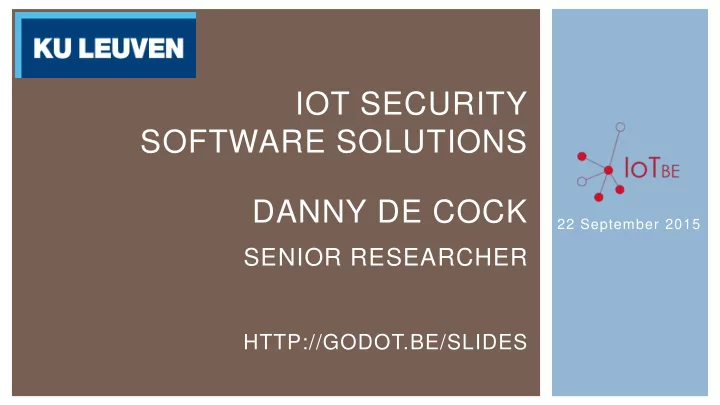

IOT SECURITY SOFTWARE SOLUTIONS DANNY DE COCK 22 September 2015 SENIOR RESEARCHER HTTP://GODOT.BE/SLIDES
STANDARD CRYPTO-TECHNICAL CONSIDERATIONS IOT = big data, focused on functionality, not security Security is afterthought Each family of devices works in its own silo, aggregation rather than integration User data, preferences, behavior stored in the cloud Who manages the cloud, who is it and where can you find them? Devices push data out automatically to meet user expectations and convenience Location privacy, behavior patterns, backups, contact lists No transparency to end-user wrt access to company/private data Authentication, confidentiality and authorization problems Low power = lightweight communications and security protocols Silo- based management of keys, preferences, access control settings… 22/09/2015 2
SO, WHAT IS THE PROBLEM? IoT device not different from any other IT device Communicates with its surroundings Firmware, operating system, applications, application data, user data, configurations What makes IoT different Restrained resources Not continuously online Many different versions in the field Very short time-to-market Users are Guiney pigs rather than users of well tested devices High number of devices compete for limited network resources Wifi, Bluetooth, ZigBee, Z- Wave… Operation conditions are complex and fragile Just too many devices and more are coming 22/09/2015 3
‘‘OUR SYSTEM IS SECURE: WE USE THE AES’’ What about Key management & life cycle ‘‘Random’’ keys? Authenticated (?) key agreement Implementation Modes of encryption, initialization vectors,… Attacking the implementation Who holds the keys? Who can use the keys? Stored in the clear? Key archives? 22/09/2015 Slide 4
HIGH-LEVEL RISKS (1/2) Focus on Functionality – better & earlier than the competition Commercial interest – user is no longer owner of its data Struggle with Reliability of the devices Stability of the applications Interoperability with other devices 22/09/2015 5
HIGH-LEVEL RISKS (2/2) Forget/ignore/neglect Privacy related issues Collecting all possible data without informing users correctly and beforehand Inappropriate use of information `it is available anyhow, so why not use it?` Integrity protection of data transferred and stored Access control to IoT device, online services, user data, configuration data… Happy when it works Do not touch/reconfigure a working system Limited management of keys, algorithms, protocols, credentials… Backward compatibility constricts deployment of secure environments 22/09/2015 6
IT’S ALIVE! AND WE LOST IT! Networked devices Automated data push to the cloud – sensor states, control statuses, user data… Frequent system updates and upgrades Flooding off the shelve (home) wireless access points Lower- power Bluetooth, ZigBee… hubs Devices get controlled remotely – who controls what? Botnet-inspired command and controlled push of commands from the Cloud ET phones home: fetch instructions from mother station 22/09/2015 7
REAL DANGER – OPEN SESAME Third party’s benefit Hacking/infecting remote control points Very similar to botnet activities Compromised meta-controller, e.g., Can provide full access to critical control points Enables perfect burglary Break-in & entry without signs of break-in! Compromised device manufacturer’s control points Alien firmware, Trojan behavior of *all* devices Self-benefit Current state of the art allows fabrication of alibi Fake presence at home Mimic normal behavior remotely Disclaimer: not claiming the pictured items/service providers have been compromised already 22/09/2015 8 Images: http://www.sevenoaksart.co.uk
WHAT TO DO ABOUT IT? (DESIGN/DEVELOP VIEW) During design of IoT devices and services: Enable & use robust version and update control from the initial start: Firmware, operating system, application, application modules, device drivers Key material, set of trusted references: keys, certificates Avoid transporting and saving plaintext data to the cloud Enable decent user and system authentication & authorization Special focus on user friendliness & user convenience Similar to TPM initialization: master and normal user Good system design relies on embedded security Simplifies security issues: no add-on During use: Guarantee interoperability with older versions Discard support of older versions when *ALL* older versions have upgraded Inform users correctly and completely when changing data collection policy 22/09/2015 9
WHAT TO DO ABOUT IT? (USER VIEW) Apply well known network segregation: Demilitarized zones & self-controlled security gateways! During configuration of intelligent devices Prepare separate networks from normal network with Internet access Use different settings to initialize/configure devices/services and to use devices/services After configuration Disable Internet access of critical intelligent devices – power consumers, physical & logical entry points Disable automated update functionality to avoid unwanted/uncontrolled service disruption 22/09/2015 10
CLOSING REMARKS Use of Today’s IoT devices provide No privacy guarantees whatsoever Fake belief you are in control New business opportunities for IoT system aggregators IoT system installers and configurators About home automation Not to be used for safety and security critical systems 22/09/2015 11
QUESTIONS? Contact details: Email: Danny.DeCock@esat.kuleuven.be Slides: http://godot.be/slides 22/09/2015 12
GOOD PRACTICES Centralize security knowledge in software architects and application designers Implementers should not have to make delicate security decisions Cryptographic algorithms and protocols should be considered as modular building blocks Consistent deployment of a security vision saves time and money Security expertise concentrated in a few of the most trusted members of the development organization Allows for better depth of knowledge Results in more effective and secure results Good initial security design avoids hard to solve security issues Security patches do not deal with inherent design flaws Simple design is easily understandable/testable/auditable 22/09/2015 Slide 13
TH@NK YOU! ANY QUESTIONS? 22/09/2015 Slide 14
Recommend
More recommend